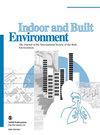A mathematical model for predicting indoor PM2.5 concentration considering uneven mixing and fractional efficiency of a filter
IF 2.9
3区 工程技术
Q2 CONSTRUCTION & BUILDING TECHNOLOGY
引用次数: 0
Abstract
Indoor PM 2.5 control has become an essential part of ensuring high-quality indoor air quality. In this paper, to improve the prediction accuracy, an unsteady-state mathematical model for predicting indoor PM 2.5 concentration was established. Air exchange efficiency was considered to characterize the uneven mixing of particle concentration in the model. The filter efficiency of the multi-stage filter system and the actual efficiency of each stage filter were redetermined through particle size distribution and fractional efficiency of filter. The accuracy of the model was verified with existing experimental data. Furthermore, the filtration performance of different combinations of typical filters was analyzed. The results showed that when the filter was installed in the second stage in a multi-stage filter system, the filter efficiency coefficients for filtering PM 2.5 were 0.94∼0.98, and decreased to 0.81∼0.94 when installed in the third stage. As air exchange efficiency was increased from 0.6 to 0.9, the purification time was shortened by 10.86∼14.44 min. Under the large outdoor PM 2.5 concentration, indoor air quality can be guaranteed by increasing the air change rate or adding filters to enhance the filter efficiency. Moreover, there should exist a minimum air change rate to meet the required indoor PM 2.5 concentration.考虑不均匀混合和过滤器分级效率的室内PM2.5浓度预测数学模型
控制室内pm2.5已成为保证室内空气质量的重要组成部分。为了提高室内pm2.5浓度的预测精度,本文建立了非稳态室内pm2.5浓度预测数学模型。空气交换效率是表征模型中颗粒浓度混合不均匀的指标。通过粒度分布和过滤器的分级效率,重新确定多级过滤系统的过滤效率和每级过滤器的实际效率。用已有的实验数据验证了模型的准确性。此外,还分析了不同典型过滤器组合的过滤性能。结果表明,在多级过滤系统中,在第二级安装过滤器时,过滤PM 2.5的效率系数为0.94 ~ 0.98,在第三级安装过滤器时,过滤效率系数下降到0.81 ~ 0.94。换气效率从0.6提高到0.9,净化时间缩短了10.86 ~ 14.44 min。在室外pm2.5浓度较大的情况下,可以通过增加换气频率或增加过滤器来提高过滤效率来保证室内空气质量。此外,应存在最小换气率以满足室内PM 2.5浓度的要求。
本文章由计算机程序翻译,如有差异,请以英文原文为准。
求助全文
约1分钟内获得全文
求助全文
来源期刊

Indoor and Built Environment
环境科学-工程:环境
CiteScore
6.40
自引率
25.00%
发文量
130
审稿时长
2.6 months
期刊介绍:
Indoor and Built Environment publishes reports on any topic pertaining to the quality of the indoor and built environment, and how these might effect the health, performance, efficiency and comfort of persons living or working there. Topics range from urban infrastructure, design of buildings, and materials used to laboratory studies including building airflow simulations and health effects. This journal is a member of the Committee on Publication Ethics (COPE).
 求助内容:
求助内容: 应助结果提醒方式:
应助结果提醒方式:


